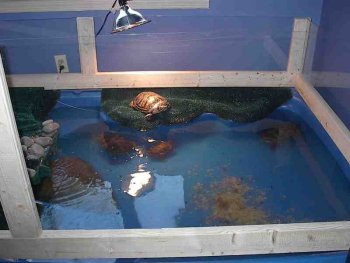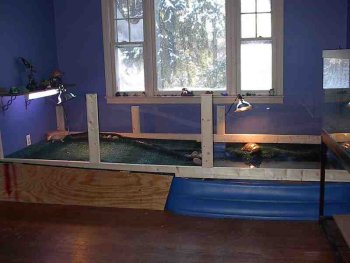 |
 |
|
|
Last Updated: 6/4/09
Introduction
Considerations
Indoor Pond Temperatures
Overwintering Pond Plants
Four Indoor Turtle Ponds
Links
This page is under construction but I do not know if I will add more to it. It was one of those pages I started but got distracted with a billion things.
For photos of a few indoor ponds, check out my Pond Showcase indoor pond page.

Having an indoor pond is much like a combination of an outdoor pond and an aquarium. For now, please visit these pages for ideas until I have time to write this page.
Fish Index
Pond Index
Tub Ponds
My 20 Gallon Indoor Tub Pond
My 50 Gallon Indoor Pond
Here are some key points for indoor ponds:

Like many of my web pages, I started this page with a lot to say and then ran out of room. Then, on 11/3/06, I answered some questions about indoor ponds and wanted to translate those thoughts to this bereft page on my site.
Here are some things to consider about indoor ponds:
Lighting:
If the indoor pond just has fish, then full spectrum fluorescents are good. If there are live plants,
then the fluorescents will keep low light plants like taro alive but that may not be enough light.
Metal halides may be needed. For indoor ponds with turtles, full spectrum fluorescents and an
incandescent heat lamp would be needed.
Filtering:
Indoor ponds should be treated like aquariums as far as filtration goes which means more
turnover and filter control than in a pond. Indoor ponds tend to be more crowded than outdoor
ones although not always. Aquarium or pond pumps and filters can be used.
Escaping Animals:
Fish will jump. Turtles will climb. Any insect larvae brought in will pupate and fly around if
they are of that sort. Nets, high edges, etc. are some ways to reduce losing animals to escape or
jumping. Also, keep in mind that indoor pets like cats and dogs may drink from or try to get
animals out of unprotected indoor ponds. But, at least those herons and raccoons will not be
visiting!
Heating:
Most indoor ponds are in the basement. This is fine for most plants and animals but some
species that need warmer temperatures may necessitate adding an aquarium heater to an indoor
pond.
Water Changes:
Indoor ponds should have more frequent water changes than outdoor ones. How much and how
often (as with outdoor ponds) depends on how many plants and animals are in there. I do about a
20% water change on my 20 gallon indoor pond every three weeks but it usually does not have
any animals in it. A 100 gallon indoor pond with a dozen koi, however, might easily require
weekly 50% water changes. When setting up an indoor pond, try to situate it so that water
changes can be done. I bail water in and out of my indoor pond but it is small. For larger ponds,
having a water outlet close enough to run a hose to fill the pond is really a requirement. As for
draining the pond, if it is on a bottom floor, you may have to use a pump to pump the water out
of a window or upstairs and out of a window. If you have the luck to design your indoor pond's
room, be sure to put in a sink and a drain. Having a drain in the bottom of the indoor pond is a
great idea.
Sunlight:
If the indoor pond has live pond plants, then certainly letting natural sunlight hit the indoor pond is a great idea and will improve things. If the pond does not have live plants, it is best to avoid getting too much direct sunlight as it will just grow algae.
Materials - the pond itself:
Indoor ponds can be made from any of the following: pre-made solid one piece plastic or rubber containers/ponds/pots as long as they are non-toxic, kiddie pools, glass aquariums, plastic storage containers, EPDM (or other) liner over a wooden frame, cement pond (made on site), fiberglass pond (made on site usually), and so on. Due to the enormous weight of water, any pond over about 50 gallons should be placed on the lowest level of the house (cement floor underneath). It is a good idea to account for a water source, draining, and a spill zone as well as all the other things.
When is an aquarium a pond? I consider a glass aquarium to be more like a pond when there is no lid, and it is open to the atmosphere, usually with plants growing out of the top. When is a pond an aquarium? Ponds can be made with glass on the sides as well as open in the top. But, if the top is open, they really still are ponds.
What animals can you add to an indoor pond? Of course, you know about fish. You can add the same animals as you have in a pond. There are some exceptions for some people. If the pond is not netted with fine mesh, having amphibians probably is not a great idea. If you do not want bugs flying around the house, then adding insects is probably not a great idea. I end up adding them when I bring in the plants anyway so my basement has various bugs all over the place from ants to crickets to ladybugs to damselflies to butterflies to moths to midges to you name it depending on what I have brought inside. If the indoor pond area is contained from the rest of the house (like an atrium), then having loose insects all around and loose frogs eating them could be a neat proposition! In such a greenhouse-type environment, I would probably even add some tropical lizards.

Ideal winter storing temperatures for indoor ponds:
If the pond animals and plants are hardy, and you want them to go dormant, then 34-50 degrees F is good. Colder is better. Lighting can be subdued. Do not feed the fish or fertilize the plants. This is ideal for a hardy tub pond or animals or plants being brought in for winter because their pond is too shallow or the climate too harsh that they would freeze solid. So, you recreate a semi-winter inside.
If you want to have an active hardy pond, then 50-80 degrees F is good. Feed the fish and fertilize the plants. This is best for ponds that are indoor year-round. Intense natural light or artificial growlights are needed.
For a tropical indoor pond to be dormant, it is best to aim for 50-60 degrees F. Do not fertilize the plants. There is a good chance they could die. For this reason, it often works better to store the plant tubers or plants in damp sand or damp sphagnum moss.
To keep an active tropical indoor pond, keep the pond at 60-100 degrees F. This pond requires intense lighting, either from the sun, multiple growlights, or metal halides. Below about 70 degrees F, the tropical plants will not grow much so try to stay above 70 unless it is short term. A heater in the pond may also be required

For now, see the overwintering plants section.

I was sent an e-mail in early February 2004 of Robin's indoor turtle pond in the basement. She gave me permission to show her photos below. The pond is made from 2x4's with plexiglass on the sides. The pond is a kiddie pool with a sliding board that the red-eared sliders use to get out of the pond.


Mark and Martha sent me five photos of their indoor turtle pond on 8/7/05. It is made from an inflatable kiddie pool reinforced with PVC piping. The turtles are red-eared sliders.
Indoor turtle pond
Indoor turtle pond
Indoor turtle pond
Indoor turtle pond - close-up of turtles
Indoor turtle pond
Dylan sent these photos of his indoor turtle pond on 4/3/09. "Made from plywood, PVC shower pan liner, and 2x2's. It is one third dirt and two thirds water. It holds about 40 gallons of water. Not completely finished but I couldn't wait to send pictures. It only cost about $80 for all of the supplies."
Indoor turtle pond - land area
Indoor turtle pond - water area
Indoor turtle pond - view farther away
Kris sent this photo of his indoor turtle pond made from a kiddie pool on 5/16/09. He has a musk
turtle and three painted turtles.:
Indoor turtle pond

Let me know if you know of other indoor pond links.
Building an Indoor Pond for the Budget Conscious
Water Gardening Under Artificial Lights

Back to the pond index.
|
|
Pet Link Banner Exchange: |

|
|
|
There have been 51,181,002 file views (file views since 2006, page views before that) to Fishpondinfo from December 1, 2003 through August 17, 2019 (stats lost after that). |
|

|

|
E-mail RobynCopyright © 1997-2025 Robyn Rhudy |

|
 |